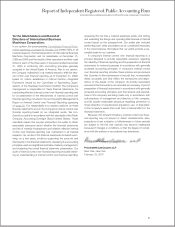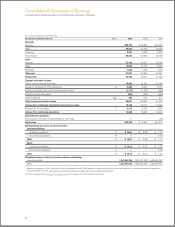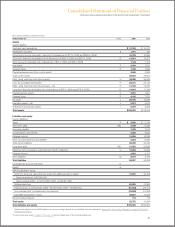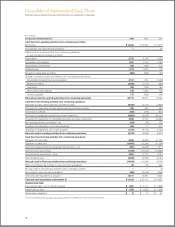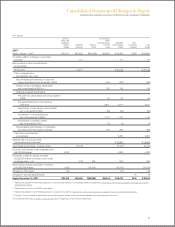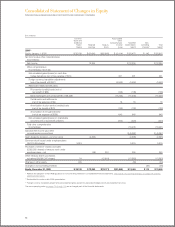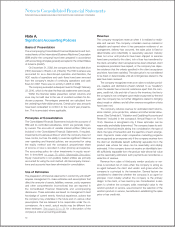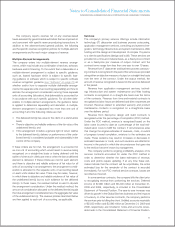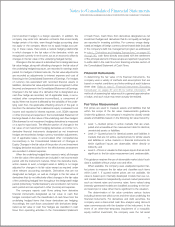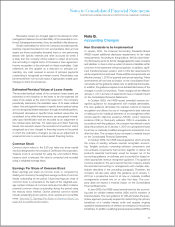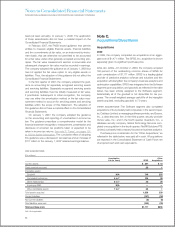IBM 2009 Annual Report Download - page 75
Download and view the complete annual report
Please find page 75 of the 2009 IBM annual report below. You can navigate through the pages in the report by either clicking on the pages listed below, or by using the keyword search tool below to find specific information within the annual report.
Notes to Consolidated Financial Statements
INTERNATIONAL BUSINESS MACHINES CORPORATION AND SUBSIDIARY COMPANIES
clients in excess of the fair value of acquired assets is recorded
as an offset of revenue and is estimated at December 31, 2009
to be $39 million in 2010, $23 million in 2011, $7 million in 2012,
$2 million in 2013 and $1 million thereafter.
In situations in which an outsourcing contract is terminated,
the terms of the contract may require the client to reimburse
the company for the recovery of unbilled accounts receivable,
unamortized deferred costs incurred to purchase specific assets
utilized in the delivery of services and to pay any additional costs
incurred by the company to transition the services.
Software Costs
Costs that are related to the conceptual formulation and design
of licensed programs are expensed as incurred to research,
development and engineering expense; costs that are incurred
to produce the finished product after technological feasibility
has been established are capitalized as an intangible asset.
Capitalized amounts are amortized using the straight-line
method, which is applied over periods ranging up to three years.
The company performs periodic reviews to ensure that unam-
ortized program costs remain recoverable from future revenue.
Costs to support or service licensed programs are charged to
software cost as incurred.
The company capitalizes certain costs that are incurred to
purchase or to create and implement internal-use computer
software, which includes software coding, installation, testing
and certain data conversions. These capitalized costs are amor-
tized on a straight-line basis over two years and are recorded
in selling, general and administrative expense. See note J,
“Intangible Assets Including Goodwill,” on pages 89 to 90.
Product Warranties
The company offers warranties for its hardware products that
range up to three years, with the majority being either one or
three years. Estimated costs for warranty terms standard to
the deliverable are recognized when revenue is recorded for the
related deliverable. The company estimates its warranty costs
standard to the deliverable based on historical warranty claim
experience and applies this estimate to the revenue stream for
products under warranty. Estimated future costs for warran-
ties applicable to revenue recognized in the current period are
charged to cost of revenue. The warranty accrual is reviewed
quarterly to verify that it properly reflects the remaining obligation
based on the anticipated expenditures over the balance of the
obligation period. Adjustments are made when actual warranty
claim experience differs from estimates. Costs from fixed-price
support or maintenance contracts, including extended warranty
contracts, are recognized as incurred.
Revenue from extended warranty contracts, for which the
company is obligated to perform, is recorded as deferred income
and subsequently recognized on a straight-line basis over the
delivery period.
Changes in the company’s deferred income for extended
warranty contracts and warranty liability for standard warran-
ties, which are included in other accrued expenses and liabilities
and other liabilities on the Consolidated Statement of Financial
Position, are presented in the following tables:
Standard Warranty Liability
($ in millions)
2009 2008
Balance at January 1 $ 358 $ 412
Current period accruals 374 390
Accrual adjustments to reflect actual experience (11) 16
Charges incurred (406) (460)
Balance at December 31 $ 316 $ 358
Extended Warranty Liability
($ in millions)
2009 2008
Aggregate deferred revenue at January 1 $ 589 $ 409
Revenue deferred for new extended
warranty contracts 283 335
Amortization of deferred revenue (226) (134)
Other* 18 (21)
Balance at December 31 $ 665 $ 589
Current portion $ 310 $ 234
Noncurrent portion 355 355
Balance at December 31 $ 665 $ 589
*
Other consists primarily of foreign currency translation adjustments.
Shipping and Handling
Costs related to shipping and handling are recognized as
incurred and included in cost in the Consolidated Statement
of Earnings.
Expense and Other Income
Selling, General and Administrative
Selling, general and administrative (SG&A) expense is charged to
income as incurred. Expenses of promoting and selling products
and services are classified as selling expense and include such
items as compensation, advertising, sales commissions and
travel. General and administrative expense includes such items
as compensation, office supplies, non-income taxes, insurance
and office rental. In addition, general and administrative expense
includes other operating items such as a provision for doubtful
accounts, workforce accruals for contractually obligated pay-
ments to employees terminated in the ongoing course of business,
acquisition costs related to business combinations, amortization
of certain intangible assets and environmental remediation costs.
73


